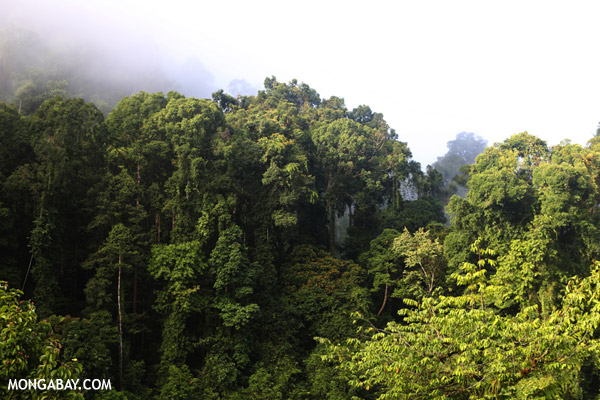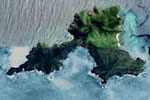
Oil palm estate in Malaysia. Photo by: Rhett A. Butler.
Ants are an important ecological group in both degraded and natural habitats. They interact with many other species and mediate a range of ecological processes. These interactions are often interpreted in the context of ant mosaics, where dominant species form strict territories, keeping other ants out. This segregation between ant species is well-documented in monoculture plantations. Now new research published in Ecography has shown that these changes are driven by the replacement of rainforests with monocultures and not the arrival of non-native species.
Sampling oil palm plantations and primary lowland rain forest in the Danum Valley Conservation Area, Sabah, Malaysia, researchers found that high degrees of species segregation, i.e. ant mosaics, were present in oil palm plantation, and were absent, or at least much weaker, in primary rainforest.
“Oil palm plantation is much hotter and drier [than rainforest]. This means that there are fewer available nesting locations that are suitable cool and damp. One of the few remaining canopy nest sites in oil palm plantation are epiphytic bird’s nest ferns, and we found high levels of species segregation for the ant communities in these ferns. This indicates that ants may be competing for these valuable resources to a greater extent than they would in primary forest, giving rise to ant mosaics,” lead author Tom Fayle, with the University of South Bohemia, and a Member of the Forest Ecology and Conservation Group, Imperial College London told mongabay.com.
Unidentified ant in Malaysian Borneo. Photo by: Rhett A. Butler. |
Fayle’s research showed that the most common [ant] species in primary forest ferns was Diacamma, a generalist predator and scavenger, while, as predicted, the most common species in plantation ferns were from two myrmicine genera, both of which are known to survive of the sweet nectar secreted by these ferns.
In rainforest there are many more tree species than in palm oil; to be precise for every species in oil palm there are 587 species rain forest across 8 hectares. The enormous reduction in complexity of the canopy that occurs when a rainforest is converted into plantation means a single ant species can dominate a single oil palm canopy (since this is a rather small, and relatively isolated habitat patch); in rainforest, even within a single canopy, there is a vast number of different habitats for ants to inhabit. A single square meter of canopy could potentially consist of multiple species of trees across different canopy layers, so even if there is a single dominant species, other species may be able to co-exist with the dominant one. This high-level of connectivity in the rainforest canopy may also make it difficult to maintain a coherent territory, at least in contrast to the more simple structure of the plantation canopy.
The study also found that non-native species might act to disassemble ant communities in oil palm plantations, but whether or not these non-native species are detrimental to other ant species, and to other animals and plants remains to be seen, at least in oil palm plantations.
“Our data indicate that these non-native species do not, in fact, compete strongly with native species,” Fayle told mongabay.com. “It may be that clearing forest merely makes the habitat more suitable for these species, while making it less suitable for native species”.
Fayle also noted that non-native ant species can actually be useful. For example, the yellow crazy ant (Anoplolepis gracilipes) has been used to control herbivores in cocoa and coconut plantations.
The exciting world of invertebrates
Given the amazing complexity of ant communities as demonstrated by Fayle’s study, it is easy to wonder why it is easier to rouse public interest in the cute and cuddly than in small creepy crawlies.
“I would certainly agree that it seems easier to excite people in general about vertebrates than invertebrates, and that it is important that scientists who work on invertebrates try to engage the public as much as possible,” Fayle, whose work can be seen at www.tomfayle.com, told mongabay.com.
An ecosystem approach, showing how important some of these species are for humans, is perhaps one way of doing this. Alternatively it might be simply be a case of getting people interested in these animals for their own sake. Fayle refers to this as “the David Attenborough method”, a good example of which is the ‘School of Ants’, a project encouraging US school children to make collections of ants.”

Rainforest in Danum Valley. Photo by: Rhett A. Butler.
CITATION: Tom M. Fayle, Edgar C. Turner and William A. Foster.Ant mosaics occur in SE Asian oil palm plantation but not rain
forest and are influenced by the presence of nest-sites and
non-native species. Ecography 36: 001–007, 2013. doi: 10.1111/j.1600-0587.2012.00192.x
Related articles
Ant surprises on Murciélago Islands in Costa Rica

(06/28/2011) The Murciélago Islands are seven small islands off the northwest coast of Costa Rica in the Area de Conservación Guanacaste (ACG), home to one of the largest intact dry tropical forests in Central America. Despite this, few scientists have studied the biodiversity of these small uninhabited islands. A new study in the open access journal Tropical Conservation Science has attempted to rectify this gap by conducting the first survey of insects, specifically ants, on the islands. Researchers were surprised at the richness of ant species on the island: 50 species were documented, only two of which were invasive species.
New species of zombie-creating fungi discovered
(03/02/2011) As everyone knows, human zombies are created when an uninfected human is bitten by a member of the brain-craving undead. But what about ant zombies? Yes, that’s right: ant zombies.
Photos: ants take top prize at Veolia Wildlife Environment Photography contest

(10/21/2010) An image of nocturnal ant silhouettes systematically devouring a leaf in Costa Rica has given Hungarian photographer, Bence Máté, the much-coveted Veolia Wildlife Environment Photographer of the Year award. In addition to being named Photographer of the year, Máté also won the Erik Hosking award, given to a young photographer (ages 18-26) for a portfolio of images, for images taken in Costa Rica, Brazil, and Hungary.
Leaf-cutter ants test theories about the Amazon’s biodiversity
(07/23/2008) No one knows for certain how many insect species reside in the Amazon. One oft-quoted estimate is 30 million, but the actual number could be significantly lower or higher than this. Either way, biologists have long wondered why the richness of insect diversity in the Americas’ tropical forests is exponentially higher than temperate forests. Three popular hypotheses have emerged—the theory of refugia, the marine incursion hypothesis, and the riverine barrier hypothesis. To test these theories a group of scientists, headed by Dr. Scott Solomon, studied three species of leaf-cutter ant species from the Amazon.